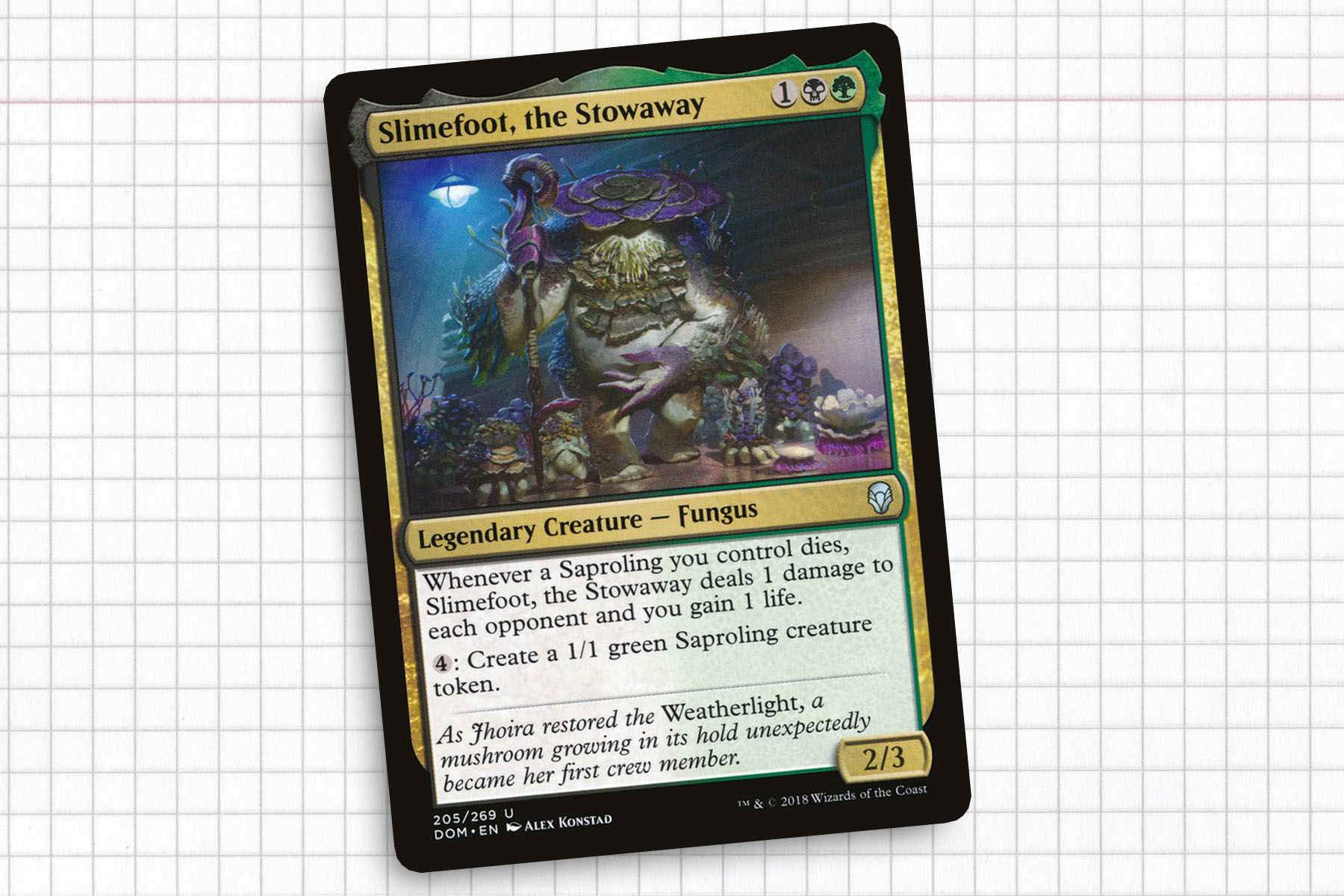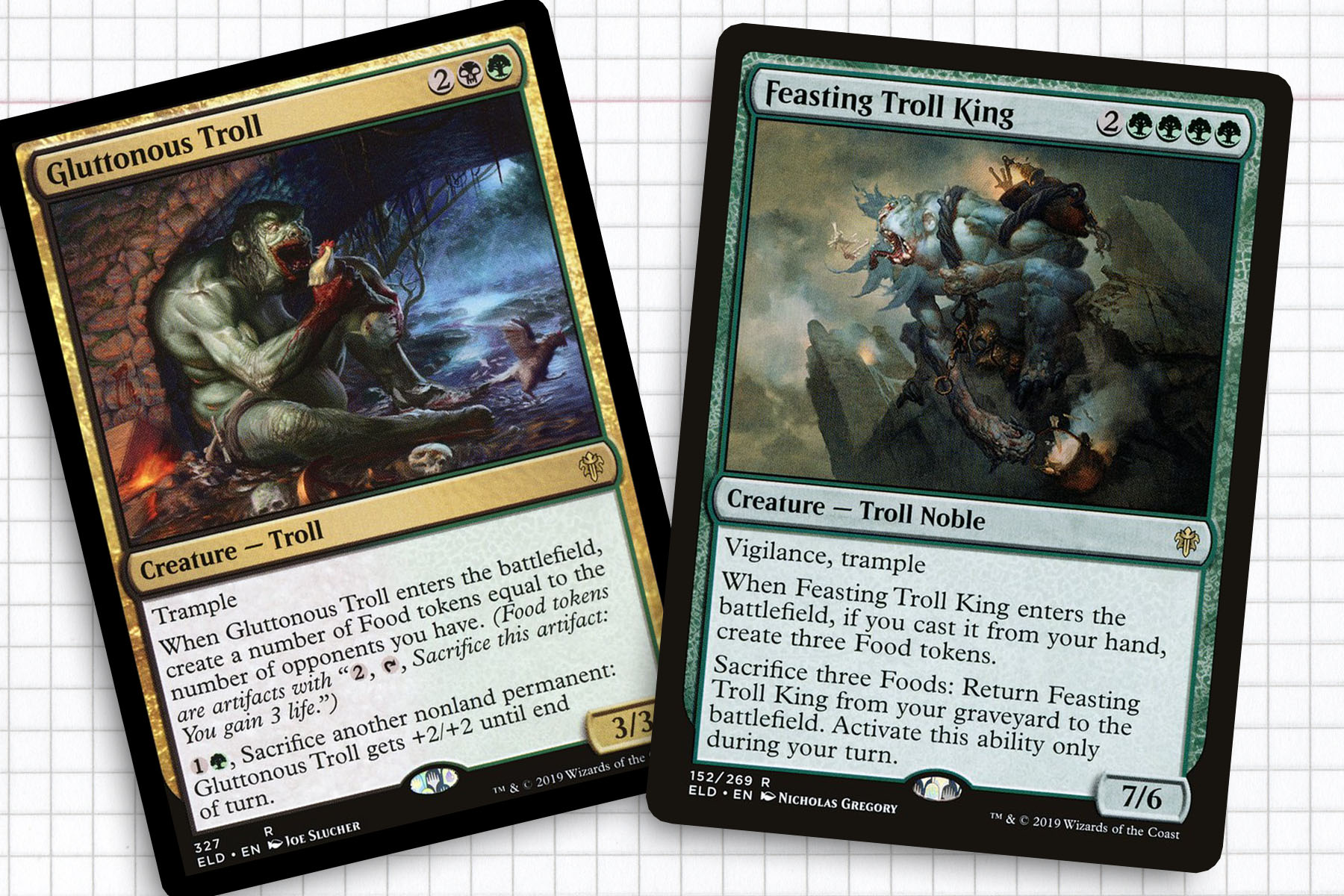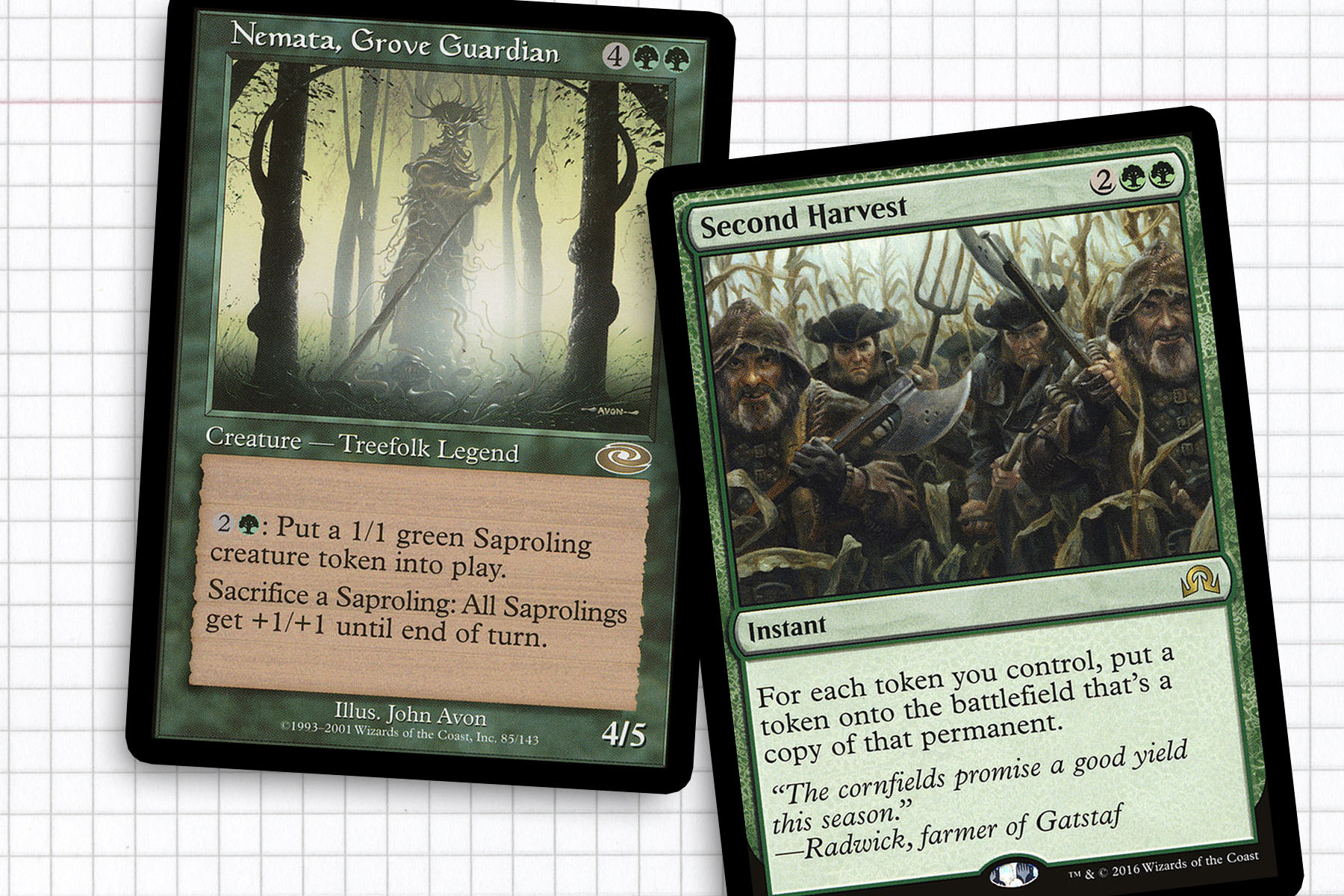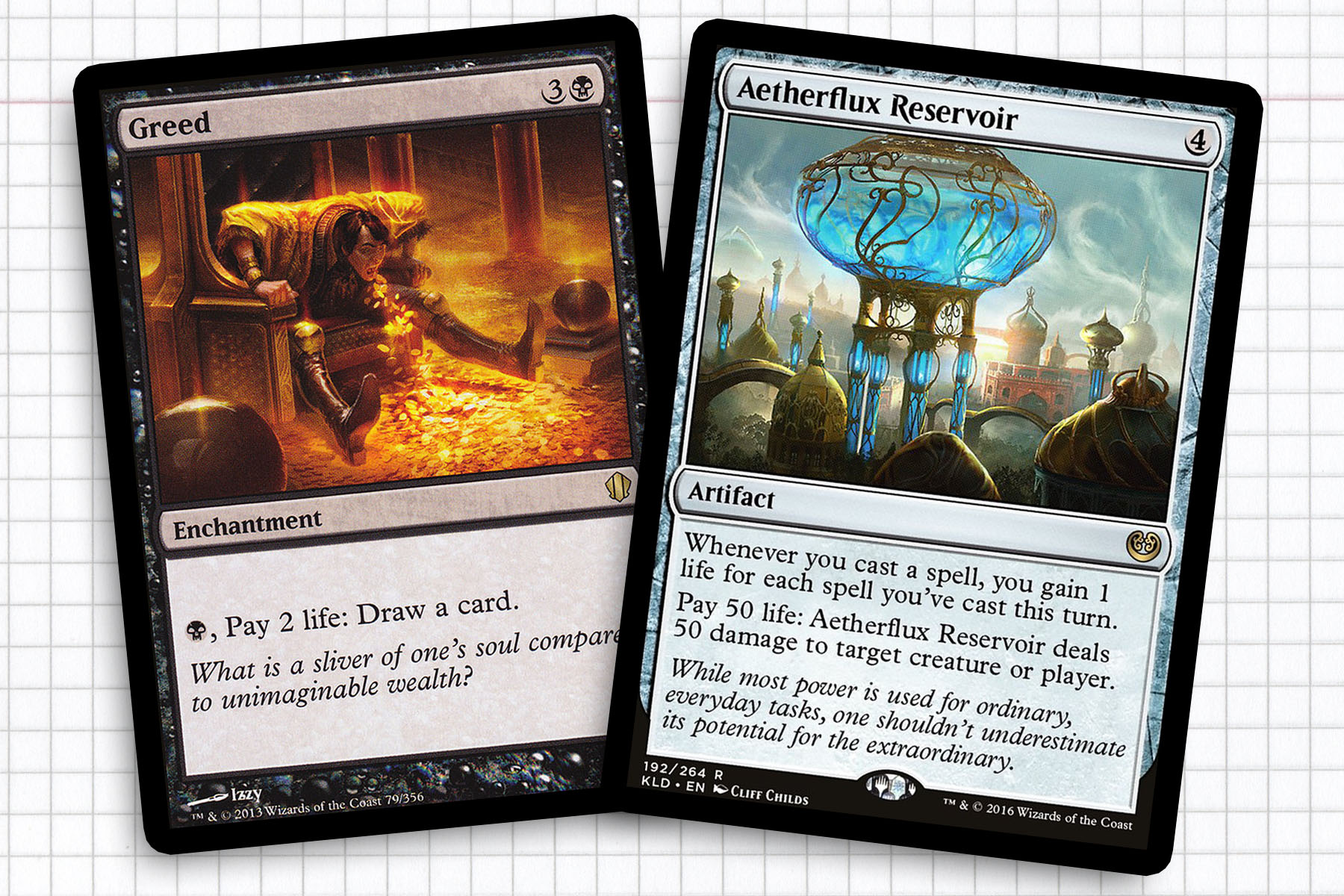As a long time Magic player, I expect that there will be times when my interest in the current set wanes. I will admit that I did not expect that one of those points would be during Throne of Eldraine. But in all honesty, with a busy schedule in the last month, I really haven’t made a deep dive into the set since it was released.
As we move into November, the season of Thanksgiving is upon us and I wanted to do something thematic of the upcoming holiday by spotlighting the food mechanic. To my chagrin there really isn’t a great option to spotlight food in a singleton format. Maybe that is the reason I never got fully enthralled with Throne. Without a legendary creature that cares about food, adventures, or even Faeries—though Alela, Artful Provocateur comes close—there’s nothing begging for me to sink my teeth into.
The Food mechanic shows up the most in Black-Green. Golgari happens to be home to a general I’ve loved since their printing, but never got off the ground floor with: Slimefoot, the Stowaway. With food in mind, Slimefoot can serve an entire buffet; setting the table before finally sweeping the battlefield empty for the win. We will be aiming to play out a war of attrition, hopefully taking the table down before they can do the same to us.

Our Savior, Slimefoot
This week’s general came into Magic in a peculiar way. Slimefoot, the Stowaway grew out of a small spore attached on the hull of the reconstructed skyship Weatherlight on Dominaria. As such he became an unofficial member of Captain Jhoira’s crew—a cross between a mascot for the legendary skyship and a humble deck swab. Passengers are warned to keep out of Slimefoot’s way, but the grumpy fungoid is easily plied with food.
Slimefoot made a lot of waves in the Minnesota Commander metagame when it first came out, most prominently in that hands of Vorthos Mike when he assembled his budget build around the fungus. The card called out to me early in the Dominaria preview season for its mix of linear tribal themes and the open-endedness that came from being a solid token commander. Of course, life and content cycles can sometimes get in the way of even the best plans.
I’m very excited to look at a deck that shares a lot of qualities with another deck I’ve talked about in the past—more on that later. Even down to the fact that more powerful generals exist to pilot this deck, but I want my own flavor.

Edible Cardboard
As the crux of my deck, cards with the food mechanic are going to take up a sizable portion. While parsing through the list of available cards, something that stood out to me was a certain lack of power-level quality. Even so, I will say that the power level of mechanics in Commander is often not that important in the grand scheme of things, since we are allowed to invest our card selections into more flavorful themes over strictly perfect Magic. Much value can be gained from our creatures and spells adding a delayed life boost.
As such, it’s wise to consider the following card for our deck skeleton:
Food: Bake into a Pie, Curious Pair, Feasting Troll King, Fierce Witchstalker, Foreboding Fruit, Giant Opportunity, Gingerbrute, Gluttonous Troll, Golden Egg, Insatiable Appetite, Savvy Hunter, Taste of Death, Trail of Crumbs, Witch’s Oven, Wolf’s Quarry
This deck boasts a signature kill spell, combat trick, and edict effect in form of Bake into a Pie, Insatiable Appetite, and Taste of Death. I think that is actually a very good start. The most versatile overall may be Feasting Troll King, Savvy Hunter, and Foreboding Fruit, even if we never cash in the lifegain.

Tokens, Tokens, Tokens
With any Slimefoot deck, of course we’re going to want to play into Saproling tribal. While our general can reliably create creature tokens for us, it’s important to keep back-up plans for token production stored away within our deck as well. My longtime favorite is Sprout Swarm, which can be an army in a can. Similarly, Jade Mage and Nemata, Grove Guardian do very good impressions of our general and Sprout Swarm. And finally, with all the different tokens we should be expecting to see leaving the battlefield, Mazirek, Kraul Death Priest and Poison-Tip Archer are going to provide irreplaceable value.
Piggybacking off our saproling theme, we are looking to increase the amount of tokens we can pump out with cards like Second Harvest, Parallel Lives, and Primal Vigor. While these three cards are traditionally linked to creature strategies, they will also be helping our non-creature tokens as well. This is how we can slowly build towards winning the game through a war of attrition, bolstering our battlefield and life total.

Making Use of Extra Life
As befitting a Food-themed deck, gaining life forms the second core of our deck. It’s a strong subtheme, at least. In the past, I have talked about my Doran, the Siege Tower deck built around weaponizing life gain as either a Voltron deck or a combo kill. Luckily, this deck shares two colors with my Doran concoction. While we can’t use Rhox Faithmender or have access to win conditions like Felidar Sovereign and Test of Endurance, we have strong combo pieces like Sanguine Bond and Defiant Bloodlord, along with potent mass removal like Toxic Deluge.
Decks with a “life gain package” get criticized because the life gain is unnecessary but draws hostile attention from rest of the table. Mostly I agree. But if you are properly masking extra life with Greed or Erebos, God of the Dead, you can gain life without raising any red flags when opponents assess life totals from time to time. The endgame here will ultimately be hoping that we can find our copy of Aetherflux Reservoir to be able to threaten a defeat to anyone looking to cross you, a fun answer as it forces politics in a very tangible way.
For all the spotlights cast on Whip of Erebos, the card in the god weapon cycle that I always had the most love for was Bow of Nylea. For a card that I rarely see cast, the amount of stuff this card does is mind boggling. It fits in this deck because it can be a form of repeatable life gain when you need it, but my most common activation is returning cards to my library. Maybe not enough to outpace a mill deck, but often the right stuff for when we need to tutor something we’ve already used.
Revenge of Ravens was the kind of card that snuck past me during preview season. But it takes the template of a favorite of mine, Hissing Miasma, and adds life gain. And then there is Vilis, Broker of Blood, who will take advantage of our bolstered life total by being removal and a draw engine. If nothing else, I’m finding a copy for my Doran deck.
I love a deck that stays resilient game after game. Some of my favorite decks can haphazardly overextend without meaning to. But with Slimefoot, I would like to think it could easily mitigate even my most impulsive instincts by always offering a back-up plan just a draw step away. Honestly, that’s one of the most attractive parts of a token deck, because they create game pieces and break free of our hundred card deck limits.
I hope you have a deck that really speaks to you and if you don’t, I hope there is a kernel of an idea of one in your mind, just waiting to be assembled.
Ryan Sainio is a Graphic Designer who writes about EDH and the EDH community. He has been playing Magic: The Gathering since 7th Edition in 2002 and values flavorful and fun gameplay over competitively optimized decks.



